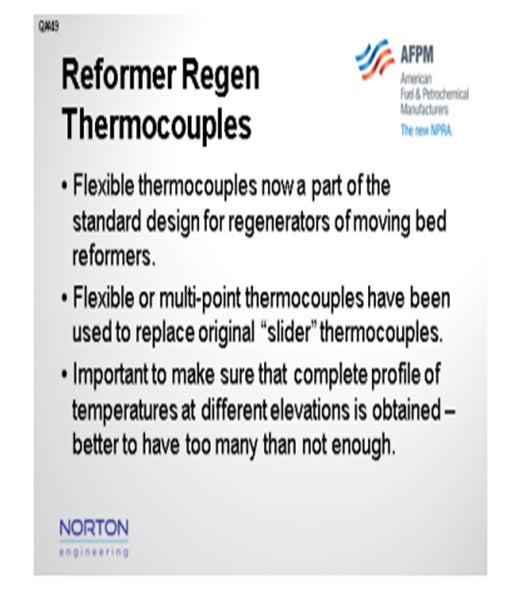Question 49: Does the panel have any experience using flexible thermocouples in the regeneration section of a moving-bed reforming unit? What considerations should be given to revamping units that do not have these installed?
STEVES (Norton Engineering Consultants, Inc.)
Flexible thermocouples, as I understand, are now a part of the standard design for regenerators of moving-bed units. At a refinery in which I worked; we replaced the original slider thermocouples with multipoint thermocouples. In this particular case, there were three sets of thermocouples installed on the outside of the regeneration screen in order to obtain temperature readings in the bed. Each thermowell contained eight thermocouples spaced at one- foot intervals down a length of the screen. When specifying these types of thermocouples, it is important to determine if a representative cross-section of temperatures is being collected for the bed.] You can easily obtain many temperature readings. As mentioned in my answer to Question 31, proper temperature monitoring can be critical to ensure that the burn is progressing properly and that there are no temperature excursions. In my mind, it is better to have too many temperatures than not enough and potentially be running blind.

DUBIN (Axens North America)
What Chris said is true for Axens. The standard design would include flexible thermocouples. They do offer the ideal ability to locate the temperature measurement points exactly where you desire them. Also, the number of points can be significantly increased with a minimum number of nozzle projections off the side of your regenerator.
PATRICK BULLEN (UOP, A Honeywell Company)
Our standard offering for the CycleMax is to use the flexible thermocouples. Most units are either Gayesco or Daily Thermetrics. Daily Thermetrics is very popular right now. The main issue is replacement in old atmospheric units. It is difficult to use the Gayesco or Daily Thermetrics systems due to space considerations and the logistics of getting the thermocouples into the regenerator area.
R.K. (RICK) GRUBB (Chevron Products Company)
Do you have much experience with thermocouples in a fixed-bed reformer?
DUBIN (Axens North America)
At Axens, we have completed revamps of fixed-bed reactors with the addition of thermocouples. On older units, avoiding welding on the shell is often desired. Ideally, it is preferable for you to make use of an existing nozzle.